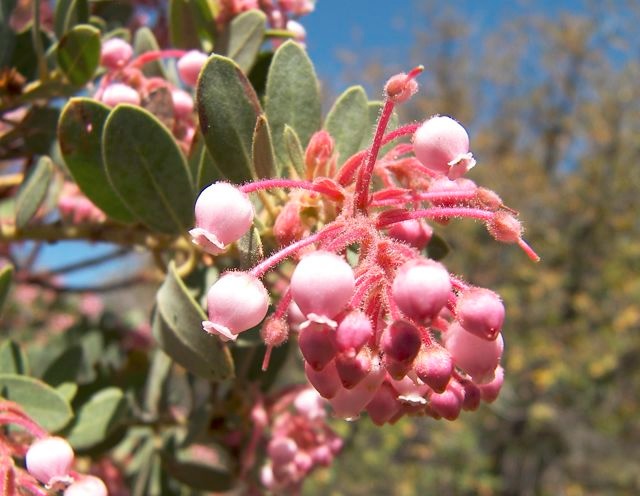 Growing Manzanita - December 21, 2016 Jeff Schalau, Agent, Agriculture & Natural Resources University of Arizona Cooperative Extension, Yavapai County Of all the native shrubs in north central Arizona, manzanita is the most popular. Gardeners (including myself) love this plant for its graceful form, reddish bark, flowers and fruit, and drought tolerance. For these reasons, people want to plant more of it in their landscapes. However, it is not readily available in most retail nurseries probably because it is somewhat slow to grow and planting survival is sometimes variable. Manzanita is related to heather (Family: Ericaceae). Four species of manzanita are found in northern Arizona. In Yavapai County, we have three species: yellowleaf manzanita (Archtostaphylos pringlei), pointleaf manzanita (A. pungens), and greenleaf manzanita (A. patula). All grow between 2 and 4 meters tall, have reddish bark, and grow on slopes between 3,500 and 8,000 feet in elevation. These species are usually difficult to find in local nurseries, but some small, native plant nurseries may have them. Bearberry or kinnikinnick (A. uva-ursi) is a prostrate growing manzanita species. It creeps along the soil surface reaching a height of 15 cm (6 inches) and is grown commercially by nurseries in California. It is native to Arizona in the Lukachukai Mountains of the Navajo Nation. This is a good choice for landscapes due to its low growth and decreased fire hazard. Some backyard gardeners enjoy propagating their existing manzanita plants using “air layering”. Here a tender shoot is "pinned" (using a "U" shaped piece of wire) into the soil where it is left to take root for a growing season. You should slightly wound the stem with a sharp, clean knife and give it some supplemental water to promote root growth. You could also apply some rooting hormone (naphthaleneacetic acid: NAA or indolebutyric acid: IBA or a combination) to the clean wound. After roots become established, the rooted plant can be severed from the mother plant, allowed to recover, and transplanted in fall following recovery. Manzanita plants can also be grown from seed although some treatment is necessary to break the hard seed coat. To prepare the seed, fruits are soaked in water to remove the fleshy pulp. Commercial growers soak seeds in sulfuric acid for 3 to 6 hours. Sulfuric acid is very caustic and not recommended for home use. Visit the online edition (see URL below) to see photos and descriptions of local manzanita species. In nature, manzanita seeds germinate following fire. Fire provides a combination of exposure to heat/smoke and seedbed preparation. To mimic this natural process, some propagators sow seeds in a flat and burn a 3-4 inch layer of pine needles on top of the seedbed. Seeds may take a year to germinate. Once seedlings germinate, they are transplanted to nursery containers. This is the technique I would recommend for adventurous home gardeners that cannot use air layering. Before you get totally inspired to grow manzanita, I should interject a word of caution: living manzanita plants contain a high percentage of volatile compounds, which, if preheated by advancing fire, will burn like a torch when ignited. They also carry a large amount of dead wood, making them all the more flammable. Manzanita can act as a ladder fuel in landscapes, especially when planted adjacent to flammable structures such as homes, decks, fences, and trees. Ladder fuels carry fire from the ground where it can be controlled to treetops and structures where it is difficult to control. Avoid these risks by isolating manzanita plantings away from flammable plants or structures and periodically removing the dead wood. Native manzanita plants are usually found on dry sites with well-drained soils. Established manzanita should be irrigated carefully if at all – too much water can damage or kill established manzanita. Similarly, fertilizers should not be applied to these hardy native plants. Locally adapted, native plants can and will form beneficial relationships with soil microorganisms such as mycorrhizal fungi if left to their natural tendencies. These beneficial relationships are less likely to develop where nutrients are abundantly available. Just say “no” to fertilizers on native plants. Manzanita is an integral component of our chaparral vegetation community and provides benefits for wildlife, birds, and insects. Hummingbirds, moths and butterflies, and other insects are attracted to the urn-like flowers. Growing manzanita is not easy, but it can be done - if you dare. Follow the Backyard Gardener on Twitter – use the link on the BYG website. If you have other gardening questions, call the Master Gardener help line in the Camp Verde office at 928-554-8992 or e-mail us at verdevalleymg@gmail.com and be sure to include your name, address and phone number. Find past Backyard Gardener columns or provide feedback at the Backyard Gardener web site: http://cals.arizona.edu/yavapai/anr/hort/byg/.  Additional Information Yellowleaf manzanita (Archtostaphylos pringlei) Yavapai County Native and Naturalized Plant Database cals.arizona.edu/yavapaiplants/SpeciesDetail.php?genus=Arctostaphylos&species=pringlei Pointleaf manzanita (Archtostaphylos pungens) Yavapai County Native and Naturalized Plant Database cals.arizona.edu/yavapaiplants/SpeciesDetail.php?genus=Arctostaphylos&species=pungens Greenleaf manzanita (Archtostaphylos patula) Yavapai County Native and Naturalized Plant Database cals.arizona.edu/yavapaiplants/SpeciesDetail.php?genus=Arctostaphylos&species=patula |